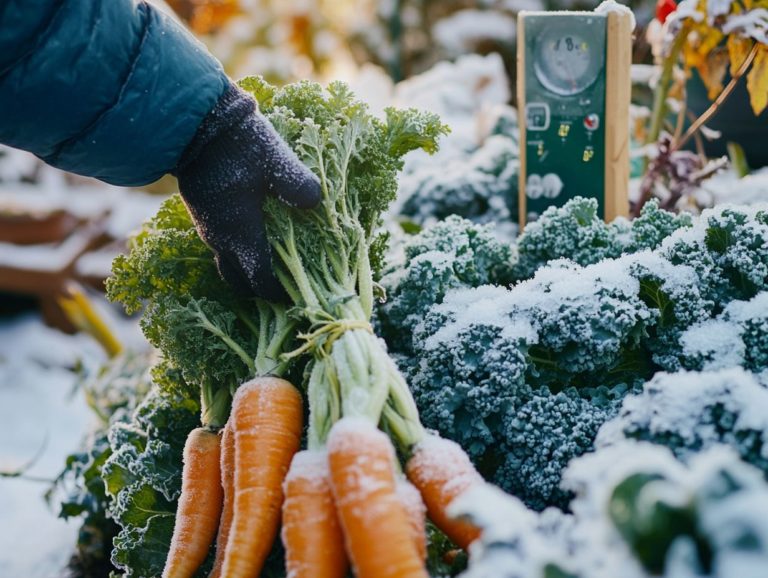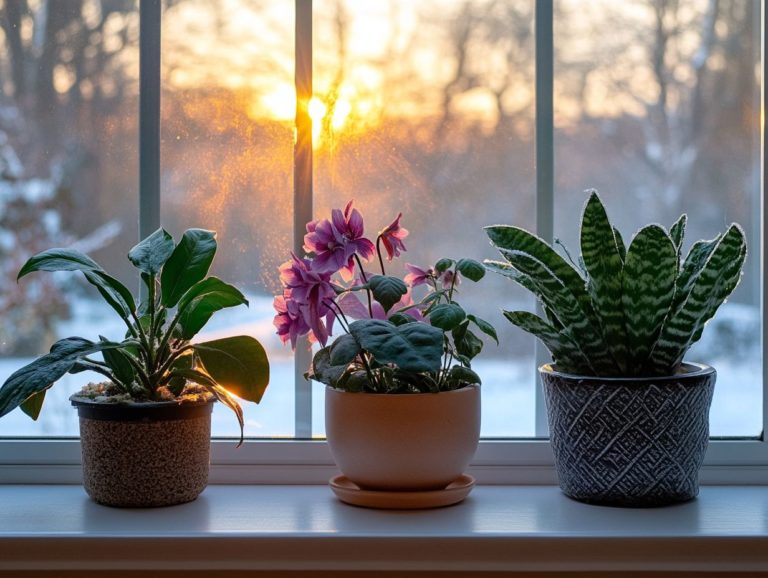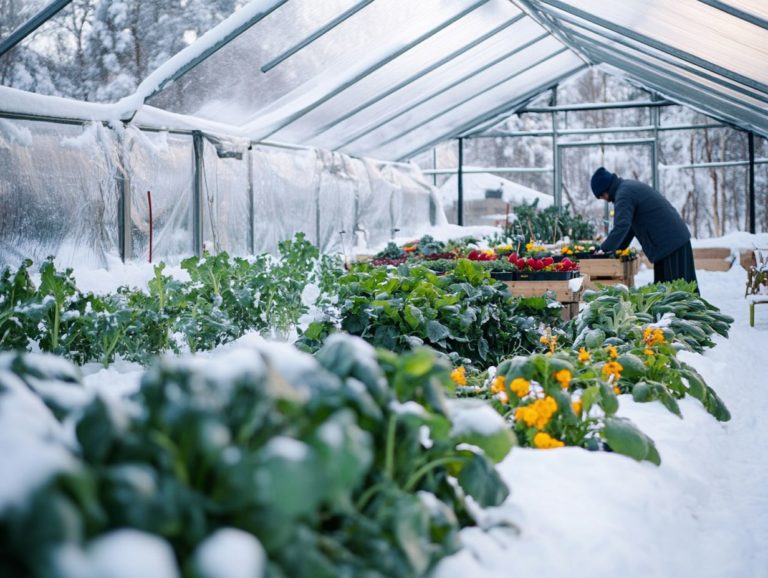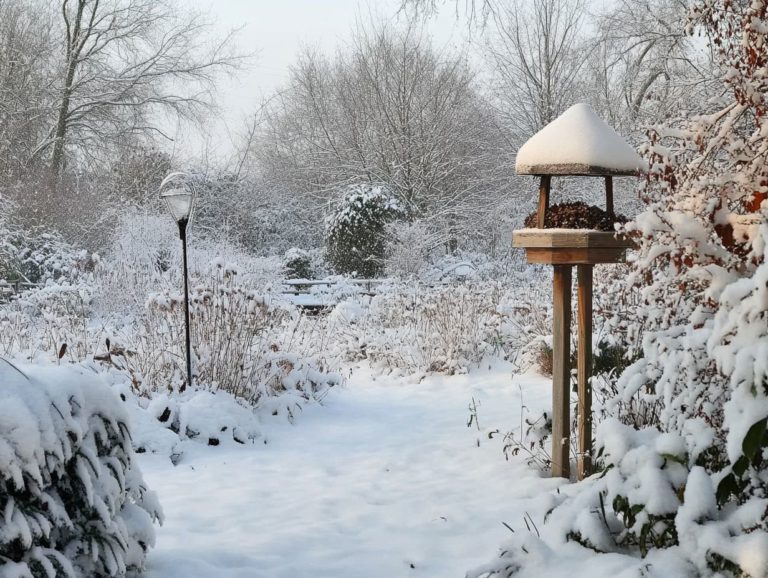How to Make a Winter Gardening Checklist?
Winter gardening might appear intimidating at first glance, yet it presents an exceptional opportunity to nurture resilience and beauty in your outdoor sanctuary.
This guide delves into the many benefits of caring for your garden during the colder months. Key preparations involve tidying up and safeguarding your plants, alongside practical tasks like pruning, mulching, and winter watering.
Uncover the finest crops to cultivate in winter and gather insights for maintaining your garden through the chill. Embrace the season, and watch as your garden flourishes year-round!
Contents
- Key Takeaways:
- Benefits of Winter Gardening
- Preparing Your Garden for Winter
- Essential Tasks for Winter Gardening
- Recommended Winter Crops
- Winter Garden Maintenance
- Frequently Asked Questions
- 1. What is a winter gardening checklist?
- 2. Why do I need to make a winter gardening checklist?
- 3. How do I make a winter gardening checklist?
- 4. When should I start making a winter gardening checklist?
- 5. Are there any tools or supplies I should include in my winter gardening checklist?
- 6. Is it necessary to follow a winter gardening checklist every year?
Key Takeaways:

- Don’t neglect your garden during the winter months, as there are many benefits to winter gardening, such as extending the growing season and improving soil health.
- Prepare your garden for winter by cleaning up and protecting plants, as well as creating a winter garden plan to ensure a successful and organized season.
- Essential tasks for winter gardening include pruning trees, mulching, watering, and fertilizing. Recommended crops to grow include vegetable seeds, herbs, and flowers that thrive in colder temperatures.
Benefits of Winter Gardening
Winter gardening presents a wealth of benefits that can elevate your garden into a vibrant ecosystem, even as temperatures drop. By utilizing eco-friendly products and essential gardening tools, you can shield your plants and set the stage for a bountiful harvest in spring.
This approach not only fosters the health of your garden but also enhances compost management, resulting in nutrient-rich soil that nurtures vigorous plant growth. Winter gardening also lets you connect with nature, alleviate stress, and beautify your landscape during the colder months.
Preparing Your Garden for Winter
Preparing your garden for winter is a vital step in ensuring its health and vitality come spring. This process involves a meticulous clean-up, where you remove debris, tackle any persistent weeds, and address drainage issues that could impact your plants.
It’s essential to tend to your irrigation system, safeguarding it against freezing temperatures, while relocating vulnerable plants to more sheltered locations to provide them with the necessary winter protection. By taking these proactive measures, you get ready for a thriving garden this spring!
Cleaning Up and Protecting Plants
Cleaning up your garden in preparation for winter means removing dead plants, debris, and leaves to create a healthy space for your shrubs and trees. This process enhances not just the aesthetics of your space but also acts as a shield against diseases and pests that flourish in cluttered settings.
A well-maintained garden during this season greatly strengthens the resilience of your plants. Pruning, in particular, is a strategic move; it stimulates new growth and mitigates the risk of disease by allowing sunlight and air to penetrate more effectively.
Using plant covers gives your plants extra warmth against winter s chill. These techniques not only promote a tidier garden but also set the stage for its vibrant revival in spring.
Investing your time into these practices can yield a garden filled with vibrant blooms and lush greenery, making every moment spent nurturing your space truly worthwhile.
Creating a Winter Garden Plan
Creating a comprehensive winter garden plan is crucial for maximizing both the productivity and health of your garden during the colder months. To assist with this, refer to a winter garden maintenance checklist that encompasses late-season planting strategies for both vegetables and flowers, alongside the strategic placement of mulch to ensure optimal soil insulation.
A well-structured garden plan not only prepares you for the nuances of winter gardening but also enhances the effectiveness of your efforts in maintaining a vibrant landscape, regardless of the weather conditions. By planning carefully, you can create a winter garden that thrives.
As you embark on this seasonal endeavor, it s vital to select hardy plants that can withstand the chill. Perennials with excellent cold resistance, such as hellebores and winterberries, will infuse your landscape with both color and texture.
Timing is of the essence; ideally, planting should take place in early fall, allowing roots to establish themselves before frost arrives. Mulching is a critical component, serving as a protective blanket of insulation while also retaining moisture and suppressing weeds during the dormant months.
By concentrating on these key tasks, you can cultivate a sustainable and lively outdoor space that endures the season s challenges.
Essential Tasks for Winter Gardening

The essential tasks for winter gardening are vital for maintaining a healthy and vibrant garden during the colder months. This involves using the right gardening tools for pruning trees and shrubs, which not only prevents overgrowth but also enhances air circulation, meaning the movement of air around your plants.
A comprehensive clean-up of your garden is equally important. Removing debris helps eliminate potential havens for pests and diseases, fostering a healthier environment.
By focusing on these key tasks, you can transform winter gardening into a rewarding and productive experience.
Pruning and Mulching
Pruning your trees and shrubs is an essential part of winter gardening that helps your plants grow well and minimizes the risk of disease. During this process, you can expertly remove dead or damaged branches, improve air circulation, and sculpt your plants for optimal growth. Don t forget to add mulch around the base of your plants; it acts as a superb insulator, retaining soil moisture and regulating temperature throughout the winter months.
Timing is key when it comes to pruning; late winter or early spring is often the sweet spot, allowing your plants to heal before the growing season kicks in. Ensure you have the right tools on hand sharp pruning shears, loppers, and saws will provide clean cuts, minimizing stress on your plants. For mulching, consider organic options like wood chips, straw, or shredded leaves. They not only serve as insulation but also enrich your soil as they break down.
Pruning helps your plants now, while mulching supports them in the long run, ensuring your garden remains vibrant and flourishing, even in the coldest months.
Get ready to transform your garden! Start your winter garden plan today for a thriving landscape all season long!
Winter Watering and Fertilizing
Winter watering and fertilizing are unsung heroes of winter gardening. They play a vital role in keeping your plants healthy throughout the season. Adjust your irrigation system for reduced evaporation. This ensures your plants receive the moisture they need to avoid stress during chilly months.
Choose eco-friendly fertilizers. They give plants the nutrients they need and help the environment, creating a thriving ecosystem in your garden. Prioritizing these practices keeps your plants nourished and flourishing.
Regularly monitor soil moisture levels. Many gardeners underestimate their plants’ water needs in winter. Water during warmer parts of the day so plants can soak up moisture before nighttime frost. Adding mulch retains soil moisture and insulates roots against freezing temperatures.
Using a slow-release fertilizer ensures nutrients are delivered gradually, reducing the risk of nutrient loss during winter rains. With these thoughtful strategies, your winter garden can survive and thrive, making the transition to spring seamless and beautiful.
Recommended Winter Crops
Cultivating recommended winter crops elevates your garden s yield, ensuring you have fresh produce even in colder months. Certain vegetables, herbs, and flowers are well-suited for winter gardening. They bring flavors and vibrant colors to your landscape, even in frosty conditions.
Robust varieties like kale, garlic, and winter herbs thrive in lower temperatures and deliver essential nutrients. Choose the right crops for a thriving winter garden that bursts with life!
Vegetables, Herbs, and Flowers to Grow
Selecting the right vegetables, herbs, and flowers is crucial for a vibrant garden. Crops like carrots, Brussels sprouts, and resilient herbs such as thyme can thrive in frigid temperatures. Adding flower varieties like pansies brings color and cheer to your winter landscape.
If you want to expand your winter gardening, consider adding kale and spinach. These greens withstand frost and often become sweeter in colder temperatures. Herbs like parsley and cilantro provide fresh flavors in your kitchen during the chillier months. Don t overlook ornamental cabbages; they add unique textures and colors to enhance your garden’s appeal.
As you plant, ensure these crops get plenty of sunlight and protection from strong winds. These elements can significantly impact their growth and vitality.
Winter Garden Maintenance

Winter garden maintenance is crucial for keeping your garden vibrant and pest-free. Regularly monitor for pests and stick to a garden checklist, including how to start your winter gardening early, to keep your space in prime condition throughout winter.
This involves routine tasks like clearing away dead foliage and protecting your plants from potential threats. Act now to fortify your winter garden and beat the cold!
Monitoring and Addressing Potential Issues
Monitoring your winter garden is crucial for plant health. Watch out for pests that might invade as temperatures drop.
Don’t neglect any drainage problems that could cause waterlogging. By taking proactive steps, you can help your plants survive winter and thrive in spring.
Regular inspections and timely interventions are key to a successful winter gardening experience.
Be on the lookout for common pests like aphids and spider mites, which can easily survive the winter in your garden beds. Check for signs of fungal diseases that thrive in damp conditions. Implement natural pest repellents or introduce beneficial insects to effectively mitigate infestations.
To tackle drainage problems, ensure that raised beds are prevalent to promote better water movement and reduce the risk of roots suffocating in saturated soil. By incorporating these preventative measures, you can create a resilient environment, even in the harshest winter months.
Final Checklist and Tips for Successful Winter Gardening
A final winter gardening checklist makes your tasks easier. It should include essential clean-up duties and eco-friendly products, along with a seasonal soil preparation checklist for gardens to keep your garden strong through winter.
Start by compiling a list of necessary tools like frost blankets, mulch, and soil amendments. Don’t forget to include the top 10 must-have tools for winter gardening to prepare your garden bed effectively. It’s also wise to inspect your tools, ensuring they are clean and ready for action.
Review the types of cold-hardy plants that thrive in your climate to guide your planting and protection decisions. For more detailed insights, check out how to plan a cold-climate vegetable garden. Don’t overlook tasks like pruning perennials and organizing garden supplies; these actions can significantly enhance your garden’s health throughout the winter season.
By embracing these practices, you can create a nurturing environment that flourishes even in frigid temperatures.
Frequently Asked Questions
1. What is a winter gardening checklist?
A winter gardening checklist lists tasks to keep your garden healthy in winter.
2. Why do I need to make a winter gardening checklist?

A winter gardening checklist helps ensure that your garden survives the harsh winter conditions and is ready for the spring season. For detailed guidance, check out this resource on how to winterize your garden. It also helps to keep track of important tasks that need to be completed.
3. How do I make a winter gardening checklist?
To make a winter gardening checklist, first assess your garden’s needs based on its specific plants and climate. Then, list tasks such as pruning, fertilizing, and protecting plants from frost. For a comprehensive approach, refer to this seasonal gardening checklist for cold climates. Finally, create a schedule and prioritize tasks based on their importance.
4. When should I start making a winter gardening checklist?
The best time to start making a winter gardening checklist is in late fall, before the first frost. To help you prepare effectively, consider exploring best practices for winter gardening. This will give you enough time to complete necessary tasks before the extreme cold sets in.
5. Are there any tools or supplies I should include in my winter gardening checklist?
Yes, you should include tools such as pruning shears, protective covers, and frost blankets in your winter gardening checklist. Additionally, don’t forget to review the key winter gardening supplies you need and stock up on essentials like winter fertilizer and mulch.
6. Is it necessary to follow a winter gardening checklist every year?
Yes, it is important to follow a winter gardening checklist every year as the tasks and preparations may vary depending on the severity of the winter and the condition of your garden. Incorporating tips for sustainable winter gardening also helps to ensure the long-term health of your garden.






